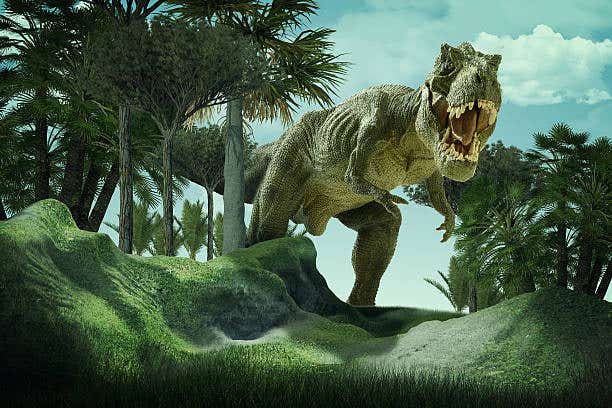The rise of T. rex: New findings explain their size and origins
Around 70 million years ago, Earth’s largest predators were dominating continents, driven by an extraordinary evolutionary shift.

A cooling climate following Earth’s hottest period triggered massive growth in predatory dinosaurs like T. rex and megaraptors. (CREDIT: iStock photo)
Around 70 million years ago, Earth’s largest predators were dominating continents, driven by an extraordinary evolutionary shift. Recent findings clarify why dinosaurs like Tyrannosaurus rex and mysterious megaraptors grew into giants. The secret to their massive size might lie hidden in the cooling climate after a period of extreme warmth.
Giants Rise as Temperatures Fall
About 92 million years ago, Earth experienced the Cretaceous Thermal Maximum, a period when global temperatures peaked. Afterward, the climate gradually cooled, creating conditions that may have helped certain dinosaurs reach massive sizes. Scientists now suggest dinosaurs like tyrannosaurs and megaraptors grew large as the climate cooled, filling an ecological gap left by earlier extinct giants.
Cassius Morrison, lead author from University College London (UCL), explains, "Our findings have shined a light on how the largest tyrannosaurs appeared in North and South America during the Cretaceous, and how and why they grew so large by the end of the age of dinosaurs."
When earlier giant predators known as carcharodontosaurids disappeared, new dinosaurs quickly occupied their ecological niches. These newcomers included tyrannosaurs in the north and megaraptors farther south. Both groups swiftly evolved into top predators, taking advantage of cooler climates to dominate their habitats.
The Mysterious Megaraptors
Megaraptors were not like the T. rex. Instead of powerful jaws, these agile hunters developed slender heads, lightweight bones, and unusually long arms ending with enormous claws measuring up to 35 centimeters. Paleontologists see them as some of the most puzzling predators because few fossils have surfaced.
Initially, scientists believed megaraptors were confined mostly to southern landmasses like South America and Australia. However, new evidence points to a much broader historical range. Early megaraptors likely evolved in Asia around 120 million years ago, spreading into Europe and eventually across Gondwana—today’s South America, Africa, and Antarctica.
Related Stories
Dr. Mauro Aranciaga Rolando from Bernardino Rivadavia Natural Sciences Argentine Museum emphasizes their widespread presence: “At the beginning of their evolutionary history, around 120 million years ago, megaraptors were part of a widespread and diverse dinosaur fauna.”
This theory means megaraptors might have lived in areas like Europe and Africa, where paleontologists have not yet discovered their remains. The scarcity of fossils makes their story harder to piece together. Morrison’s team speculates that different prey and environmental pressures might have shaped their unique anatomy, setting them apart from other dinosaurs.
T. rex's Asian Ancestors
Tyrannosaurs present a more clear-cut evolutionary trail than their mysterious cousins. Long considered North American dinosaurs, new evidence from UCL scientists reveals that their earliest ancestors originated far from North America. Using complex models analyzing fossils, geography, and climates of the past, the team discovered that ancestors of T. rex actually came from Asia.
“Our modelling suggests the ‘grandparents’ of T. rex likely came to North America from Asia, crossing the Bering Strait between what is now Siberia and Alaska,” Morrison said.
Earlier studies claimed a different North American dinosaur, Tyrannosaurus mcraeensis, was an older relative of T. rex. Morrison's group disputes this idea, asserting that fossil dating was unreliable. Instead, they support a clear Asian connection. According to their analysis, T. rex closely relates to Asian species like Tarbosaurus rather than purely North American tyrannosaurs.
Evolutionary Pressures and Global Dispersal
The research also examined how megaraptors and tyrannosaurs moved across the globe during the Late Cretaceous. These groups took different evolutionary paths, despite originating in similar regions. Tyrannosaurs evolved powerful jaws for crushing bones, whereas megaraptors developed long arms and sharp claws, perfect for hunting smaller, more agile prey like juvenile sauropods.
As the ancient supercontinent Laurasia broke apart, tyrannosaurs spread widely across Asia and North America. Megaraptors, meanwhile, diversified across southern lands after Gondwana split from Laurasia. The researchers believe these movements were influenced less by geographic barriers and more by rapid ecological changes, localized extinction events, and the emergence of new habitats.
Charlie Scherer, co-author and founder of UCL’s Paleontology Society, explained the importance of ecological shifts: “They likely grew to gigantic sizes to replace equally giant carcharodontosaurid theropods that went extinct about 90 million years ago. This extinction likely removed the ecological barrier that prevented tyrannosaurs from growing to such sizes.”
Climate Connection to Gigantism
Interestingly, gigantism didn’t consistently correlate directly with cooler temperatures. Statistical analysis indicated no clear link between body size and average yearly temperatures. Still, the overall climatic trend toward cooler conditions seemed to benefit both dinosaur groups. The extinction of other giant predators may have opened opportunities for these new giants to dominate.
Morrison’s team noted that feathers or a warm-blooded physiology might have allowed tyrannosaurs and megaraptors to better tolerate the cooling climate. This adaptability gave them an advantage over other dinosaur species less suited to changing conditions.
At their peak, tyrannosaurs like T. rex reached nine tonnes, similar in weight to a large African elephant. Megaraptors stretched to lengths of 10 meters. Both sizes represented a substantial increase from their smaller ancestors, marking a major evolutionary step driven by ecological opportunity and climatic change.
Unlocking Dinosaur Secrets
Though much remains unclear, this research has provided critical insights into dinosaur evolution during the Late Cretaceous. The broad dispersal of megaraptors and tyrannosaurs highlights how quickly dinosaurs adapted to fill gaps left by extinction events and changing climates.
These revelations also underscore the complex relationship between climate change and evolution. As Scherer summarized, the disappearance of giant predators “removed the ecological barrier” and set the stage for tyrannosaurs and megaraptors to thrive.
The scientists hope continued fossil discoveries, especially in underexplored regions like Europe, Africa, and Asia, will reveal even more details. Such discoveries could refine theories about how these ancient predators evolved and conquered their worlds, providing deeper insight into Earth’s ever-changing history.
Research findings are available online in the journal Royal Society Open Science.
Note: The article above provided above by The Brighter Side of News.
Like these kind of feel good stories? Get The Brighter Side of News' newsletter.



